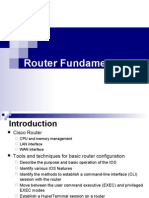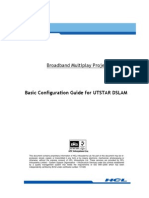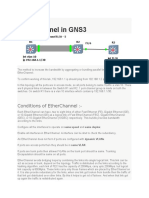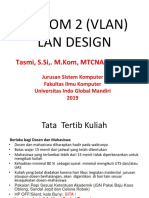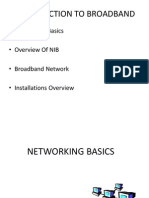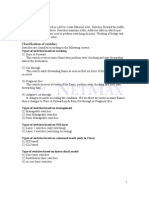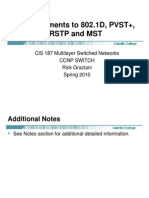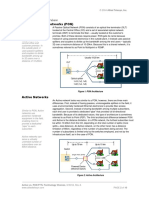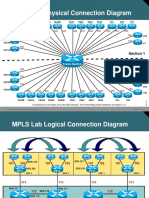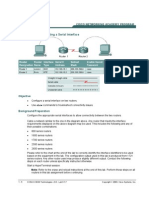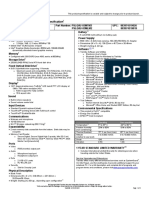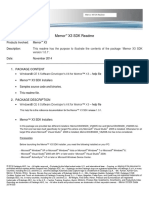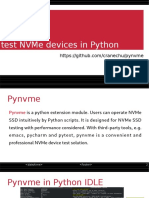Router Introduction
�Router
As a network grows larger, it is not feasible for each computer to keep track of the individual address of every other computer on the network.
�Router
There must be some scheme for reducing the amount of information, each computer has to hold locally in order to communicate with every other computer.
?
4
�Router
The scheme used to involve splitting an large network into many separate but connected networks
�Router
The job of keeping track of these discrete (ri rc) networks is then given to specialized computers called routers.
�Router
Using this method, the network computers need only keep track of the networks on the internetwork, rather than keeping track of every network computer.
�Internetwork
An Internetwork is an accepted networking industry term for a set of interconnected networks.
Network 1
Network 2
Internetwork
Network 3
�Internetwork
Each individual network will have its own network number that must be unique for that internetwork.
203.162.1.0
180.135.0.0
Internetwork
124.153.1.0
�Internetwork
Routers direct traffic through an internetwork, based on information learned from network protocols.
203.162.1.0 180.135.0.0
Internetwork
124.153.1.0
10
�Routers Function
Routers are used to route packets from one network number to another. There are two things to consider with router:
You cannot configure the same network number on more than one interface on a router. A router does not forward broadcasts by default.
11
�Network Communications
Lets take a look at the way Layer 3 network devices communication with each other. A typical workstation (a PC running a popular TCP/IP stack, for example) will require some manual configuration before it can operate on a TCP/IP network.
12
�Network Communications
At a minimum, you will have to configure an IP address, a subnet mask, and a default gateway.
IP address: 192.168.1.2 Subnet mask: 255.255.255.0 Default gateway: 192.168.1.1
IP address: 172.16.1.2 Subnet mask: 255.255.0.0 Default gateway: 172.16.1.1
S0: 200.100.100.1
S0: 200.100.100.2
E0: 192.168.1.1
E0: 172.16.1.1
13
�Network Communications
The routing decisions of a workstation configured in this manner are simple. If the workstation has to send a packet to another machine that is on the same network number, the packet is sent directly to the destination machine.
To 192.168.1.3 192.168.1.2
S0: 200.100.100.1 S0: 200.100.100.2
172.16.1.2
E0: 192.168.1.1
E0: 172.16.1.1
192.168.1.3
14
�Network Communications
If the destination is on a different network number, the packet is forwarded to the default gateway for routing through the internetwork and on to the final destination.
To 172.16.1.2 192.168.1.2
S0: 200.100.100.1 S0: 200.100.100.2
172.16.1.2
E0: 192.168.1.1
E0: 172.16.1.1
192.168.1.3
15
�Network Communications
Routers make more complex decisions.
192.168.1.2 S0: 200.100.100.1 S0: 200.100.100.2 E0: 192.168.1.1 E0: 172.16.1.1
172.16.1.2
To 172.16.1.2
16
�Network Communications
They must know how to get to all other network numbers on the internetwork and the best way to route the packets.
Which way ?
203.162.4.0
192.168.1.2
s0
s1
240.250.100.0 s1 172.16.1.2
s1
S0: 200.100.100.1 S0: 200.100.100.2 E0: 172.16.1.1
E0: 192.168.1.1
s2
s2
190.180.2.1 s0 s1
180.180.2.0
17
�Network Communications
And they need to keep track of an internetwork topology that is constantly changing due to equipment or other failures.
180.180.2.0 up or down ?
192.168.1.2 s1
s0
s1
240.250.100.0 s1 172.16.1.2
203.162.4.0
S0: 200.100.100.1 S0: 200.100.100.2 E0: 172.16.1.1
E0: 192.168.1.1
s2
s2
190.180.2.1 s0 s1
180.180.2.0
18
�Routing table
To accomplish these responsibilities, a router maintains a routing table, which lists all the known network numbers and how to get to them.
The best way to 172.16.1. 0 is through s0. s1 s0 203.162.4.0 s1 240.250.100.0 s1 172.16.1.2
192.168.1.2
S0: 200.100.100.1
S0: 200.100.100.2 E0: 172.16.1.1
E0: 192.168.1.1
s2
s2
Routing table ----------------------------S - 172.16.1.0 via s0 R - 240.250.100.0 s1 I - 180.180.2.0 s2
190.180.2.1 s0 s1
180.180.2.0
19
�Routing table
Routers also use routing protocols that keep the routing table accurate for a changing internetwork.
Network 180.180.2 .0 is down, so 192.168.1.2 s1 s1 240.250.100.0 s1 172.16.1.2
s0 203.162.4.0
S0: 200.100.100.1
S0: 200.100.100.2 E0: 172.16.1.1
E0: 192.168.1.1
s2
s2
Routing table ----------------------------S - 172.16.1.0 via s0 R - 240.250.100.0 s1 I - 180.180.2.0 s2
190.180.2.1 s0 s1
180.180.2.0
20
�Routers Components
There area two kinds of routers components:
Internal components
CPU (Central Processing Unit) ROM (Read Only Memory) FLASH NVRAM (Nonvolatile RAM) RAM (Random Access Memory) WAN LAN Console/AUX (Auxiliary : h tr)
External component (interface)
22
�Routers Components
CPU ROM RAM Console Auxiliary FLASH Interface NVRAM
23
�Internal Components: CPU
The Central Processing Unit (CPU) executes instructions in the operating system. system initialization routing functions network interface control. Large routers may have multiple CPUs.
CPU
ROM
RAM
Console Auxiliary
FLASH
Interface
NVRAM
24
�Internal Components: ROM
Contains power-on diagnostics, a bootstrap program, and operating system software. The main tasks for ROM are hardware diagnostics during router bootup and loading the Cisco IOS software from flash to RAM. ROMs are not erasable. They can only be upgraded by replacing the ROM chips in the sockets.
CPU
ROM
RAM Console Auxiliary
FLASH
Interface
NVRAM
25
�Internal Components: RAM
Random Access Memory (RAM) is split by the IOS into Main and Shared memory. Main memory is used to store router configuration and IOS data structures such as running-config, routing tables, switching cache, and ARP tables... Shared memory buffers packets waiting to be processed (This type
of memory is only used by 2500, 2600, 4000 routers. The 7000 routers have a switch processor that controls the flow of packets through the router).
The contents of RAM are lost when power is removed. RAM can be upgraded.
CPU
ROM
Main Shared
FLASH Interface
NVRAM
26
Console Auxiliary
�Internal Components: Flash
Flash memory holds the full current version of IOS running on the router. Flash memory is erasable memory that can be overwritten with newer versions of the IOS. The IOS may be in uncompressed or compressed form. In most routers (2600, 3600, 4000,) an executable copy of the IOS is transferred to RAM during the boot process. In other routers such as 2500, the IOS may be run directly from flash.
CPU ROM RAM
Console Auxiliary
FLASH Interface
NVRAM
27
�Internal Components: NVRAM
Nonvolatile random-access memory (NVRAM) is used to store the startup configuration. (NVRAM) does not lose its contents when the router is turn off.
CPU ROM RAM
Console Auxiliary
FLASH Interface
NVRAM
28
�Internal Components: Buses
Most routers contain a System bus and a CPU bus.
The System bus is used for communication between the CPU and the interfaces and/or expansion slots (This bus transfers the packets
to and from the interfaces).
The CPU bus is used by the CPU for accessing components from router storage (This bus transfers instructions and data to or from
specified memory addresses).
System Bus
Interface CPU Memory
CPU Bus
29
�External Components: Interface
The interfaces are the router connections to the outside. The three types of interfaces are:
Local Area Network (LANs). Wide Area Network (WANs). Management Ports (Console/AUX).
30
�External Components: Interface (LAN)
LAN interfaces allow the router to connect to the Local Area Network media. This is usually some form of Ethernet. However, it could be some other LAN technology such as Token Ring or Asynchronous Transfer Mode (ATM).
31
�External Components: Interface (WAN)
Wide Area Network connections provide connections through a service provider to a distant site or to the Internet.
ISP - Internet
32
�External Components: Interface (WAN)
With some types of WAN interfaces, an external device such as a CSU/DSU is required to connect the router to the local connection of the service provider (serial)
33
�External Components: Interface (WAN)
With some types of WAN interfaces, an external device such as a CSU is required to connect the router to the local connection of the service provider (serial) With other types of WAN connections, the router may be directly connected to the service provider (ISDN)- Intergrated Services Digital Network
34
�External Components: Interface (Management ports)
The function of management ports is different from the other connections. The LAN and WAN connections provide network connections through which frame packets are passed. The management port provides a text-based connection for the configuration and troubleshooting of the router. The common management interfaces are the console and auxilliary ports.
35
�External Components: Interface (Management ports)
These are EIA-232 asynchronous serial ports. (EIA: Electronic Industries Association Hip hi cng nghip in t) They are connected to a communication port on a computer. The computer must run a terminal emulation program to provide a text-based session with the router. Through this session the network administrator can manage the device.
36
�Router Connections: Console (1)
The console port is a management port used to provide out-ofband access to the router. It is used for the initial configuration of the router, monitoring, and disaster recovery procedures)
37
�Router Connections: Console (2)
To connect to the console port, a rollover cable and a RJ-45 to DB-9 adapter are used to connect a PC.
38
�Router Connections: Console (3)
The PC or terminal must support terminal emulation. Terminal emulation software such as HyperTerminal is usually used.
39
�Router Connections: LAN
In most LAN environments, the router is connected to the LAN using an Ethernet or Fast Ethernet interface.
40
�Router Connections: LAN
In most LAN environments, the router is connected to the LAN using an Ethernet or Fast Ethernet interface.
41
�Router Connections: LAN
The router is a host that communicates with the LAN via a hub or a switch. A straight-through cable is used to make this connection.
Straight-through cable
42
�Router Connections: LAN
In some cases the Ethernet connection of the router is connected directly to the computer or to another router. For this type of connection, a crossover cable is required.
Crossover cable
Crossover cable
43
�Router Connections: WAN
WAN connections may take any number of forms. A WAN makes data connections across a broad geographic area using many different types of technology. These WAN services are usually leased from service providers.
44
�Router Connections: WAN (1)
Among these WAN connection types are leased line, circuitswitched, and packet-switched.
45
�Router Connections: WAN (2)
For each type of WAN service, the customer premises equipment (CPE), often a router, is the data terminal equipment (DTE). This is connected to the service provider using a data circuitterminating equipment (DCE) device, commonly a modem or channel service unit/data service unit (CSU/DSU). This device is used to convert the data from the DTE into a form acceptable to the WAN service provider.
46
�Cisco Popular Router
Cisco 1700 module series router
1721 2501 2514 2621
Cisco 2500 built-in series router
Cisco 2600 module series router
47
